Potential Hotspots of Hamadryas Baboon–Human Conflict in Al-Baha Region, Saudi Arabia
Abstract
:1. Introduction
2. Materials and Methods
2.1. Study Area
2.2. Baboon Occurrence
2.3. Temporal Changes in Baboon Numbers
2.4. Statistics
3. Results
3.1. Occurrence of Hamadryas Baboons
3.2. Baboon Population Size
4. Discussion
Author Contributions
Funding
Institutional Review Board Statement
Data Availability Statement
Conflicts of Interest
References
- Harrison, D.L. The Mammals of Arabia, Vol. I. Insectivora, Chiroptera, Primates; Ernest Benn: London, UK, 1964. [Google Scholar]
- Harrison, D.L. The large mammals in Arabia. Oryx 1968, 9, 357–363. [Google Scholar] [CrossRef]
- Kummer, H.; Banaja, A.A.; Abo-Khatwa, A.N.; Ghandour, A.M. Mammals of Saudi Arabia. Primates. A Surv. Hamadryas Baboons Saudi Arabia. Fauna Saudi Arab. 1981, 3, 441–471. [Google Scholar]
- Biquand, S.; Biquand-Guyot, V.; Boug, A.; Gautier, J.P. The distribution of Papio hamadryas in Saudi Arabia: Ecological correlates and human influence. Int. J. Primatol. 1992, 13, 223–243. [Google Scholar] [CrossRef]
- Kamal, K.B.; Ghandour, A.M.; Brain, P.F. Studies on new geographical distribution of hamadryas baboons Papio hamadryas in the western region of Saudi Arabia. J. Egypt. Vet. Med. Assoc. 1994, 54, 81–89. [Google Scholar]
- Biquand, S.; Boug, A.; Biquand-Guyot, V.; Gautier, J.P. Management of commensal baboons in Saudi Arabia. Rev. d’Ecologie Terre Vie 1994, 49, 213–222. [Google Scholar] [CrossRef]
- Boug, A.; Islam, M.Z.; Iwamoto, T.; Mori, A.; Yamane, A.; Schreier, A.L. The relationship between artificial food supply and natural food selection in two troops of commensal hamadryas baboons Papio hamadryas (Mammalia: Primates: Cercopithecidae) in Saudi Arabia. J. Threat. Taxa 2017, 9, 10741–10756. [Google Scholar] [CrossRef]
- Judas, J.; Paillat, P.; Khoja, A.; Boug, A. Status of the Arabian leopard in Saudi Arabia. Cat News 2006, 1, 11–19. [Google Scholar]
- Lackman-Ancrenaz, I. Helping Saudi Arabia’s ‘Garbage Dump Baboons’. IPPL News 1995, 22, 5–8. [Google Scholar]
- Biquand, S.; Biquand-Guyot, V.; Boug, A. The status of hamydras baboons in Saudi Arabia. Primate Conserv. 1989, 10, 28–30. [Google Scholar]
- Ghandour, A.M.; Zahid, N.Z.; Banaja, A.A.; Kamal, K.B.; Bouq, A.I. Zoonotic intestinal parasites of hamadryas baboons Papio hamadryas in the western and northern regions of Saudi Arabia. J. Trop. Med. Hyg. 1995, 98, 431–439. [Google Scholar]
- Nasher, A.K.A. Zoonotic parasite infections of the Arabian sacred baboon Papio hamadryas arabicus Thomas in Asir Province, Saudi Arabia. Ann. Parasitol. Hum. Comp. 1988, 63, 448–454. [Google Scholar] [CrossRef] [PubMed]
- Zahed, N.Z.; Ghandour, A.M.; Banaja, A.A.; Banerjee, R.K.; Dehlawi, M.S. Hamadryas baboons Papio hamadryas as maintenance hosts of Schistosoma mansoni in Saudi Arabia. Trop. Med. Int. Health 1996, 1, 449–455. [Google Scholar] [CrossRef] [PubMed]
- Alqumber, M.A. Association between Papio hamadryas populations and human gastrointestinal infectious diseases in southwestern Saudi Arabia. Ann. Saudi Med. 2014, 34, 297–301. [Google Scholar] [CrossRef] [PubMed]
- Kasem, S.; Hussein, R.; Al-Doweriej, A.; Qasim, I.; Abu-Obeida, A.; Almulhim, I.; Alfarhan, H.; Hodhod, A.A.; Abel-latif, M.; Hashim, O.; et al. Rabies among animals in Saudi Arabia. J. Infect. Public Health 2019, 12, 445–447. [Google Scholar] [CrossRef] [PubMed]
- Olarinmoye, A.O.; Olugasa, B.O.; Niphuis, H.; Herwijnen, R.V.; Verschoor, E.; Boug, A.; Ishola, O.O.; Buitendijk, H.; Fagrouch, Z.; Al-Hezaimi, K. Serological evidence of coronavirus infections in native hamadryas baboons (Papio hamadryas hamadryas) of the Kingdom of Saudi Arabia. Epidemiol. Infect. 2017, 145, 2030–2037. [Google Scholar] [CrossRef] [PubMed]
- Dhayhi, N.S.; Arishi, H.M.; Ibrahim, A.A.Y.A.; Allah, M.B.K.; Hawas, A.M.; Alqasmi, H.; Sairam, I.; Thubab, A.; Buraik, M.; Alali, A. First confirmed case of local human rabies in Saudi Arabia. Int. J. Infect. Dis. 2019, 87, 117–118. [Google Scholar] [CrossRef] [PubMed]
- Howladar, S.; Yassin, A.S.; Khalik, K.A. Species richness of the catchment area of Al-Baha region, Saudi Arabia. Bothalia Afr. Biodivers. Conserv. 2015, 45, 64–91. [Google Scholar]
- Al-Aklabi, A.; Al-Khulaidi, A.W.; Hussain, A.; Al-Sagheer, N. Main vegetation types and plant species diversity along an altitudinal gradient of Al Baha region, Saudi Arabia. Saudi J. Biol. Sci. 2016, 23, 687–697. [Google Scholar] [CrossRef] [PubMed]
- Sigg, H.; Stolba, A. Home Range and Daily March in a Hamadryas Baboon Troop. Folia Primatol. 1981, 36, 40–75. [Google Scholar] [CrossRef]
- Zinner, D.; Klapproth, M.; Schell, A.; Ohrndorf, I.; Chala, D.; Ganzhorn, J.U.; Fischer, J. Comparative ecology of Guinea baboons (Papio papio). Primate Biol. 2021, 8, 19–35. [Google Scholar] [CrossRef] [PubMed]
- Kummer, H. Social Organization of Hamadryas Baboons: A Field Study; The University of Chicago Press: Chicago, IL, USA, 1968. [Google Scholar]
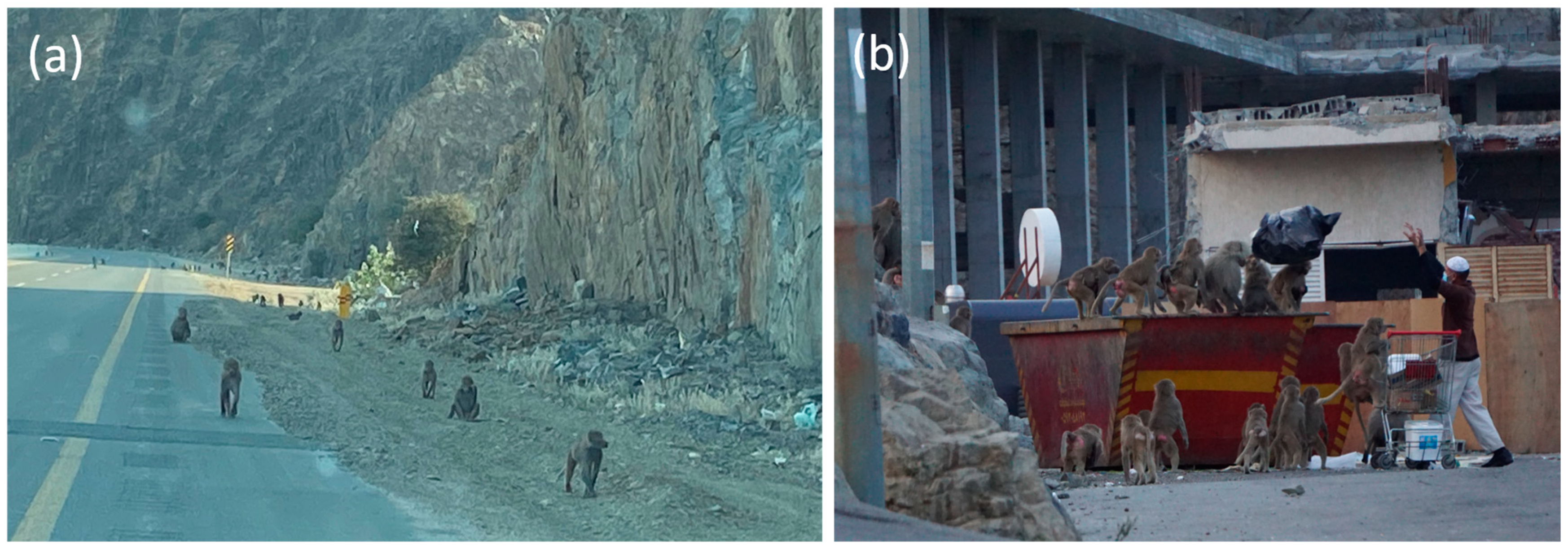
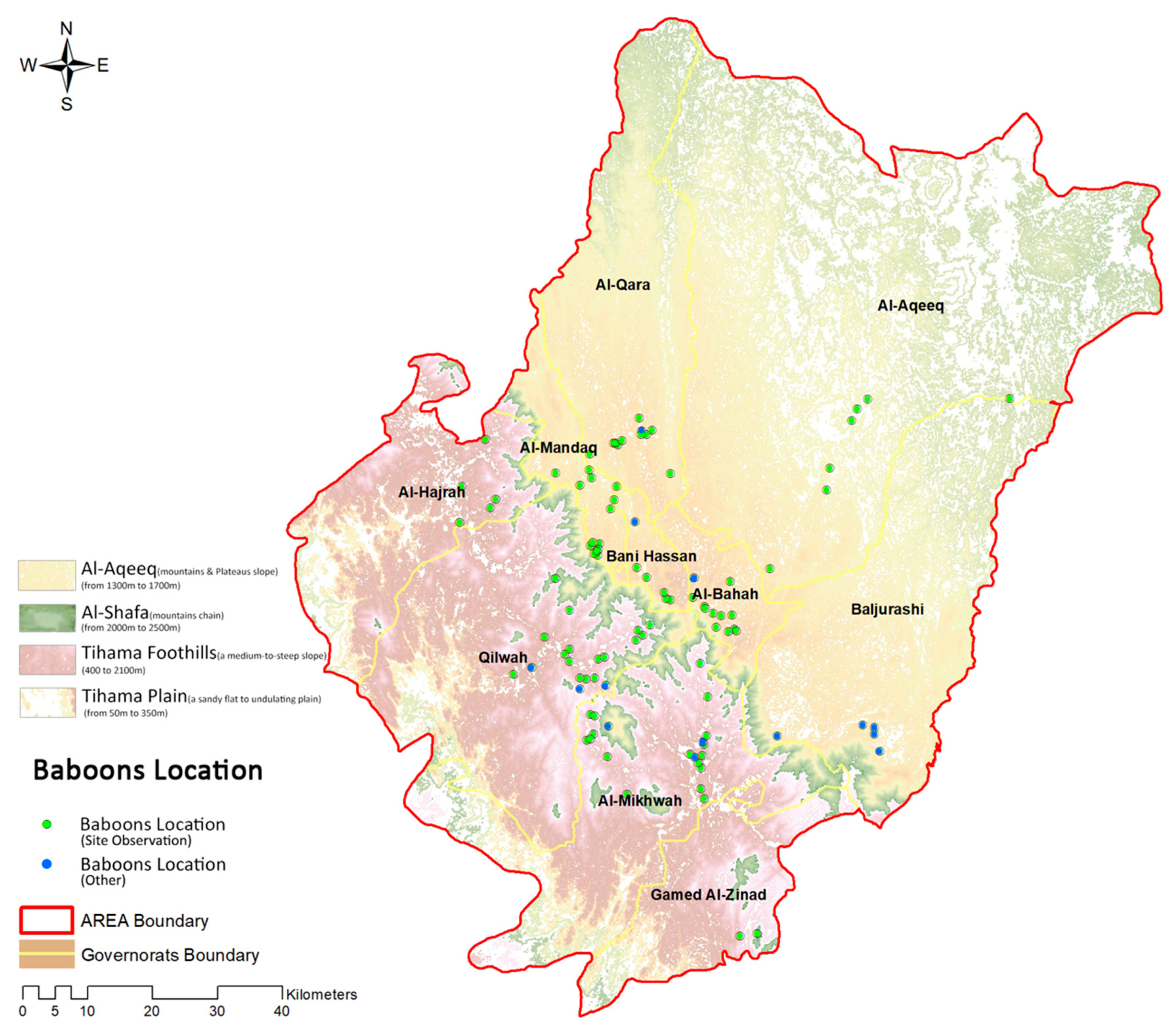
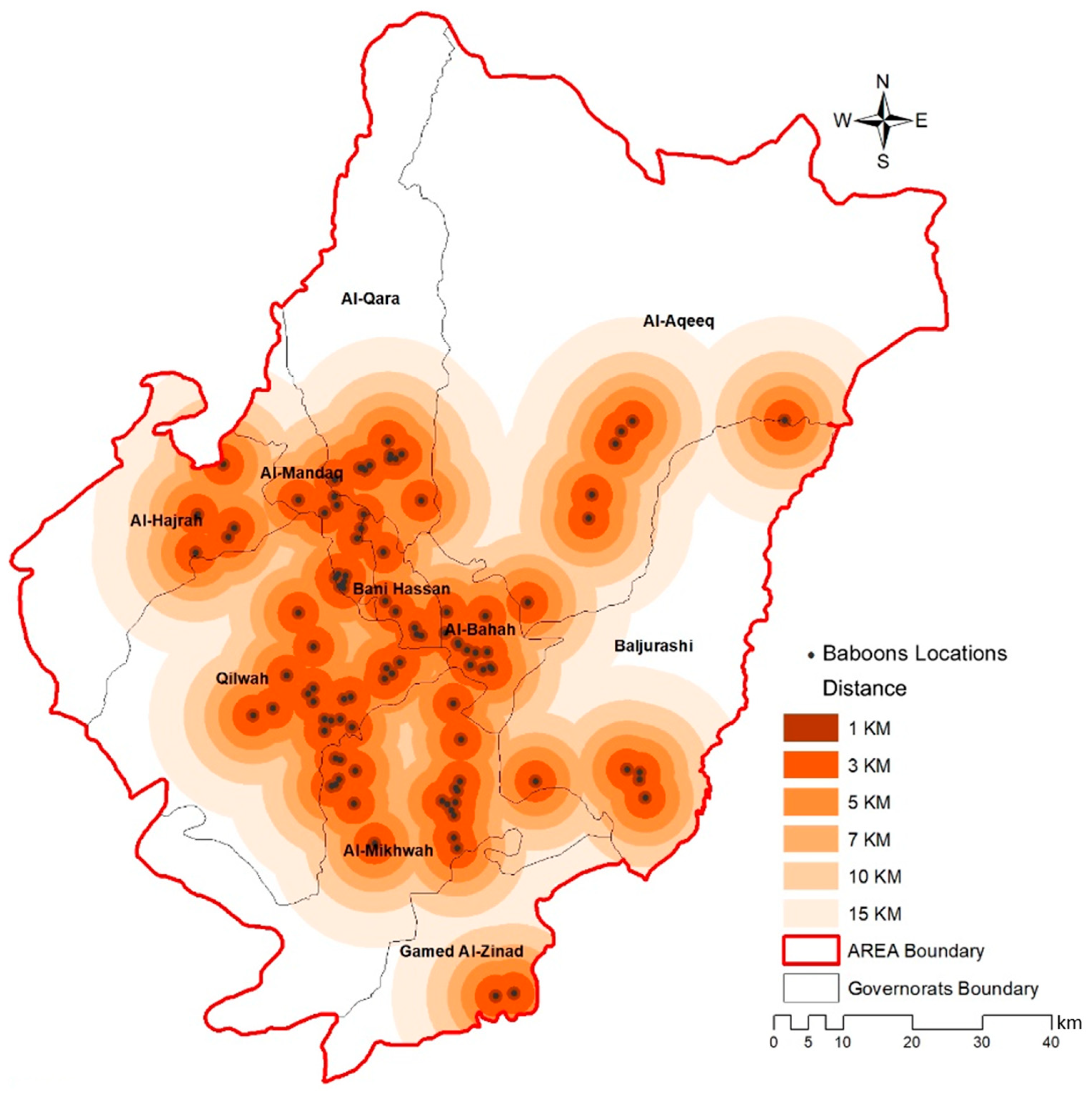

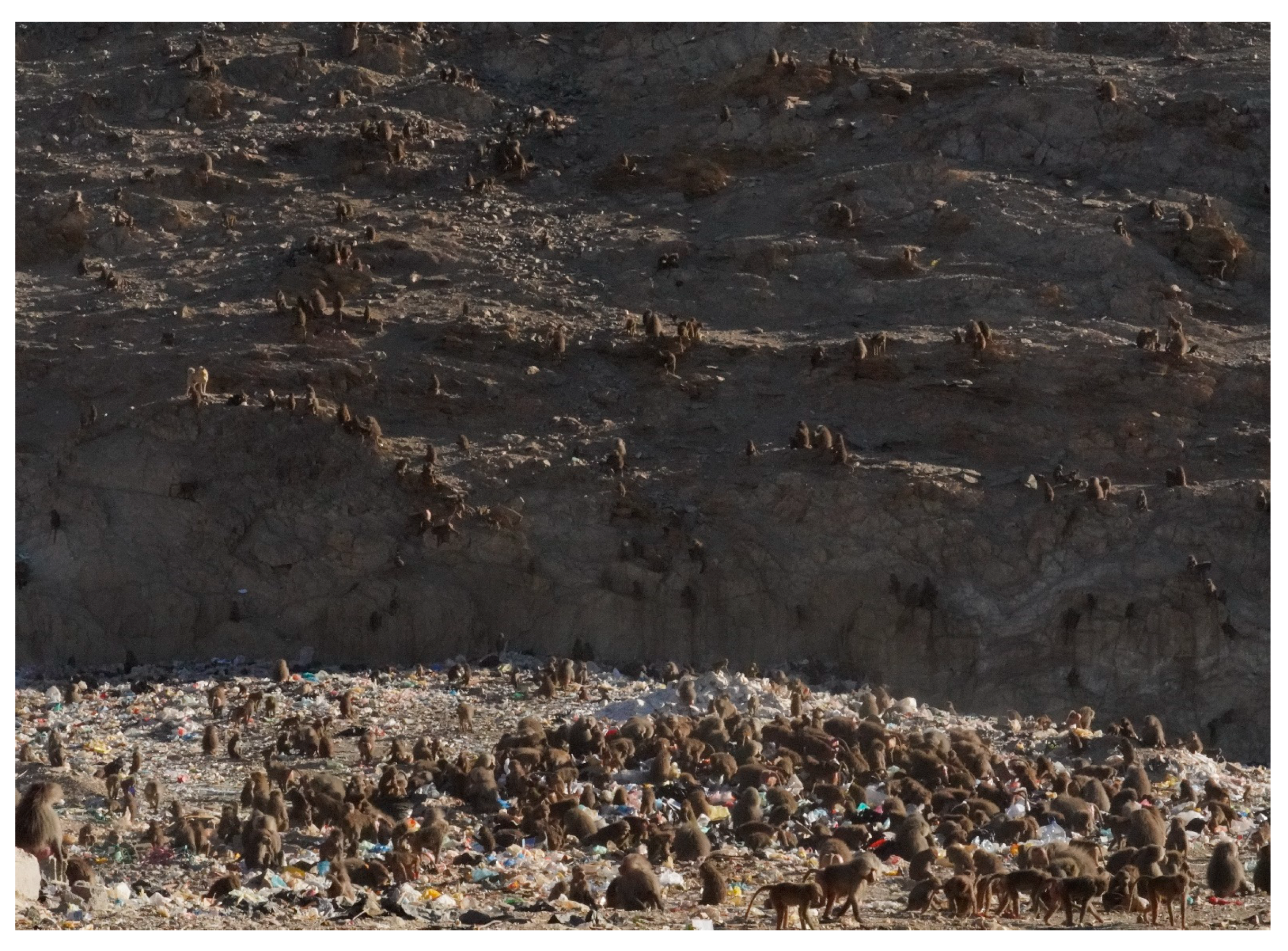
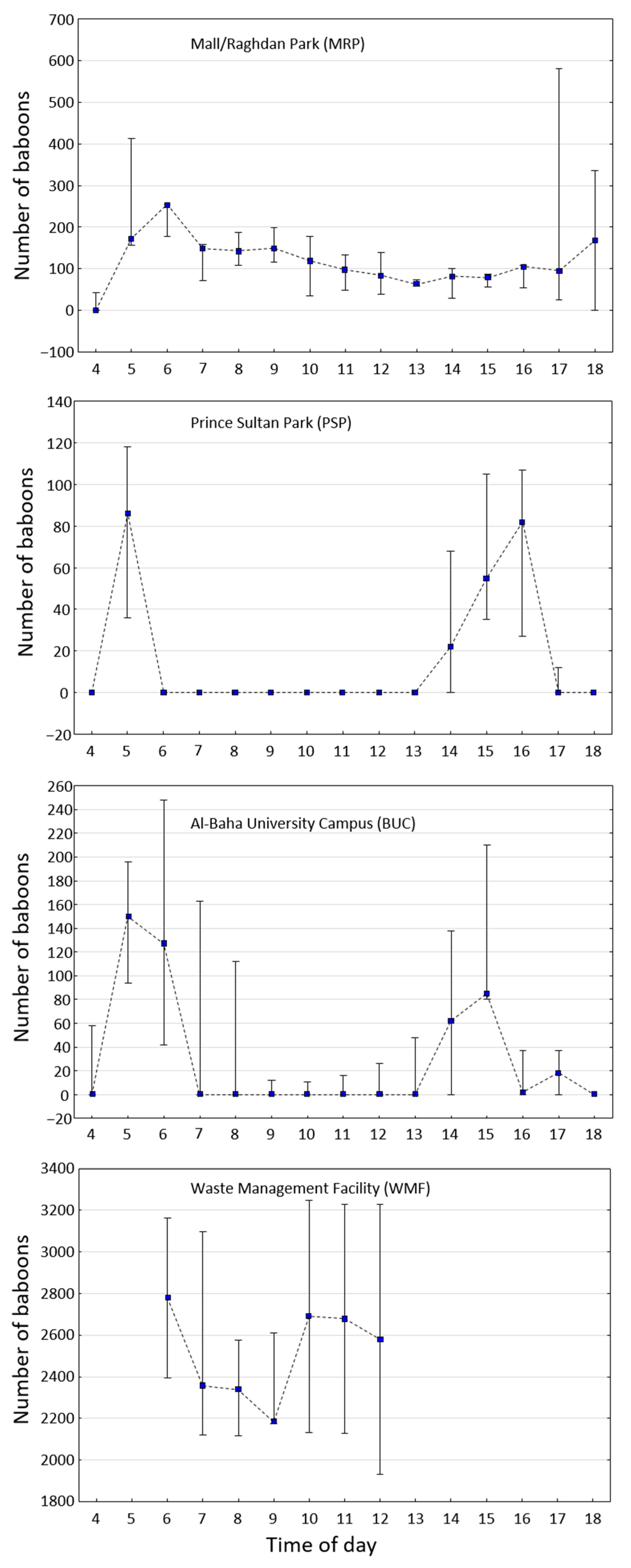
Disclaimer/Publisher’s Note: The statements, opinions and data contained in all publications are solely those of the individual author(s) and contributor(s) and not of MDPI and/or the editor(s). MDPI and/or the editor(s) disclaim responsibility for any injury to people or property resulting from any ideas, methods, instructions or products referred to in the content. |
© 2023 by the authors. Licensee MDPI, Basel, Switzerland. This article is an open access article distributed under the terms and conditions of the Creative Commons Attribution (CC BY) license (https://creativecommons.org/licenses/by/4.0/).
Share and Cite
Al-Ghamdi, G.; Alzahrani, A.; Al-Ghamdi, S.; Alghamdi, S.; Al-Ghamdi, A.; Alzahrani, W.; Zinner, D. Potential Hotspots of Hamadryas Baboon–Human Conflict in Al-Baha Region, Saudi Arabia. Diversity 2023, 15, 1107. https://doi.org/10.3390/d15111107
Al-Ghamdi G, Alzahrani A, Al-Ghamdi S, Alghamdi S, Al-Ghamdi A, Alzahrani W, Zinner D. Potential Hotspots of Hamadryas Baboon–Human Conflict in Al-Baha Region, Saudi Arabia. Diversity. 2023; 15(11):1107. https://doi.org/10.3390/d15111107
Chicago/Turabian StyleAl-Ghamdi, Ghanem, Abdulaziz Alzahrani, Saleh Al-Ghamdi, Salihah Alghamdi, Abdullah Al-Ghamdi, Wael Alzahrani, and Dietmar Zinner. 2023. "Potential Hotspots of Hamadryas Baboon–Human Conflict in Al-Baha Region, Saudi Arabia" Diversity 15, no. 11: 1107. https://doi.org/10.3390/d15111107
APA StyleAl-Ghamdi, G., Alzahrani, A., Al-Ghamdi, S., Alghamdi, S., Al-Ghamdi, A., Alzahrani, W., & Zinner, D. (2023). Potential Hotspots of Hamadryas Baboon–Human Conflict in Al-Baha Region, Saudi Arabia. Diversity, 15(11), 1107. https://doi.org/10.3390/d15111107






